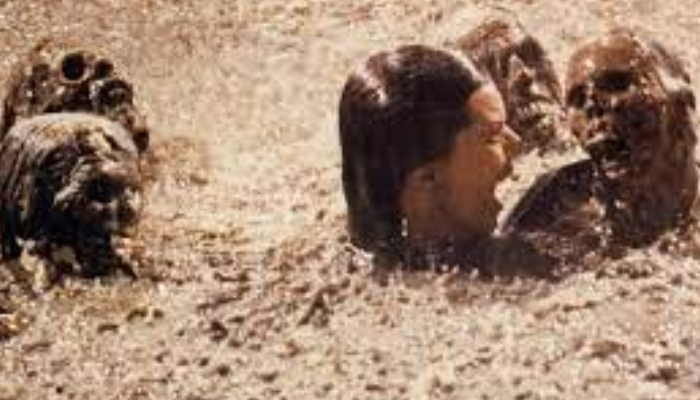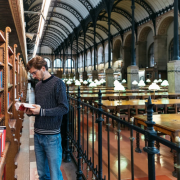The 1982 horror film Poltergeist is one of the most iconic horror films in cinema history and is known for its many iconic scenes and jump scares. But what many people don’t know is that the movie used real human skeletons as props. It has been reported that the movie used actual human skeletal remains, and the filmmakers had to get permission from the California College of Medicine to use the skeletons. This is a little-known fact about the movie that has been controversial for decades.
What is Poltergeist?
Poltergeist is a 1982 supernatural horror movie directed by Tobe Hooper and produced by Steven Spielberg. It follows the Freeling family, terrorized by ghosts in their suburban home. The movie is famous for its use of real skeletons as props. The skeletons were found in a medical supply store and were used in scenes where ghosts are seen moving around the house.
The movie received critical acclaim and was a massive success at the box office. It has since become a classic horror cinema staple of pop culture. The movie spawned two sequels and a remake in 2015. The use of real skeletons in Poltergeist has become iconic and a point of fascination among horror fans. It is a testament to the filmmakers’ creativity and the horror genre’s power.
Special Effects in Cinema
Regarding special effects in cinema, few movies have had the impact of 1982’s Poltergeist. Produced by Steven Spielberg, it is considered one of the greatest horror films ever. One of the most amazing special effects in the movie is the use of real skeletons as props. Though it was a controversial decision, it would become iconic in the horror movie genre.
Tobe Hooper directed the movie, and he wanted to make sure that the special effects in Poltergeist were as realistic as possible. He enlisted the help of special effects expert Richard Tymoff, who had worked on many horror films. Tymoff suggested using real skeletons instead of the usual rubber and plastic props. Hooper agreed, but the studio was unhappy with the idea as it was considered too gory and disturbing.
Despite the controversy, Hooper and Tymoff went ahead with the plan. Tymoff searched for skeletons from medical supply companies and eventually had two real human skeletons. He then used latex and wax to create the Poltergeist skeletons. The result was a realistic and frightening effect used in the movie’s most iconic scenes.
Though using real skeletons in Poltergeist caused controversy, it is essential to the movie’s legacy. It helped to make the movie a classic and set the standard for special effects in horror movies. The contribution of Richard Tymoff and his use of real skeletons in Poltergeist is an integral part of cinema history.
Use of Real Skeletons in Poltergeist
The 1982 movie Poltergeist is widely recognized for its terrifying special effects, but what is less known about the film is that it used real skeletons as props. The movie’s director, Tobe Hooper, was determined to make the most realistic horror movie possible and thought using real skeletons would make the movie even more authentic and frightening.
The production team obtained real human skulls and bones from a medical facility in California and used them in various scenes throughout the movie. While many skeletal remains were safely disposed of after the movie was finished, some of the bones were kept and can still be seen in the movie today. By using real skeletons, Hooper brought an added level of realism to the movie and created an even more terrifying experience for viewers.
How It Was Done
Poltergeist, the 1982 classic horror movie, is famous for using real skeletons in the film. Many have wondered how they could have achieved such realistic effects without computer-generated imagery. The answer lies in the film’s use of “Tymoff” skeletons, created using real human bones. Creating a Tymoff skeleton was quite complex and involved sourcing real human bones from various sources, sterilizing them, and then assembling them into a complete skeleton.
The bones were then attached to a metal frame with rods and screws. The dead skeleton was then suspended in a liquid latex tank to simulate skin appearance. The latex was then painted with various colors to give the skeleton a slightly more realistic look. The Tymoff skeletons were then used in the movie’s special effects to portray the creepy and scary spirits that haunted the Freeling family in the film.
These Tymoff skeletons were incredibly effective in creating a realistic atmosphere of fear and terror in the movie. Not only did they look genuine, but the use of real bones also added a layer of authenticity to the movie. Even today, Poltergeist remains one of the most iconic horror movies of all time, and using the Tymoff skeletons was an integral part of creating its lasting legacy.
Impact on Audiences
The 1982 movie Poltergeist used real skeletons as props, and this had a significant impact on audiences. The movie was one of the first to feature real skeletons in a horror movie, and it shocked and scared viewers. The realism of the skeletons made the movie even more terrifying and believable. The skeleton props were so realistic that the audience felt like they saw a natural person on screen, adding an extra layer of horror to the movie.
It also created a lasting impression on audiences, as using real skeletons in a horror movie had never been done before. This innovation created a lasting legacy, and the movie is still remembered for using real skeletons. The impact of the real skeletons in Poltergeist is still felt today and is one of the primary reasons the movie is so memorable.
Influence on Future Special Effects
The 1982 movie Poltergeist was one of the first films to use real skeletons as props. This had a significant impact on the special effects industry, as it was one of the first times that filmmakers had used such realistic props in a horror movie. The movie was released to critical acclaim and financial success, and it helped to popularize the use of real skeletons in future films. This revolutionary move in the industry helped set a new standard for special effects.
For future filmmakers, using real skeletons was an exciting prospect and helped bring a greater level of realism to their movies. This influence can still be seen today in films incorporating real skeletons into their special effects. Poltergeist was a landmark in the history of special effects, and it paved the way for many future films to use real skeletons to bring their stories to life.
Conclusion
The 1982 movie Poltergeist used real skeletons as props to bring the movie to life. Though the filmmakers took a risk with real skeletons, the gamble paid off, as audiences were terrified and enthralled by the movie. The use of real skeletons added a level of realism and authenticity to the film, which helped to make it a classic. While using real skeletons was a controversial decision, it was ultimately successful and helped to make Poltergeist one of the most iconic horror movies ever.

















Comments